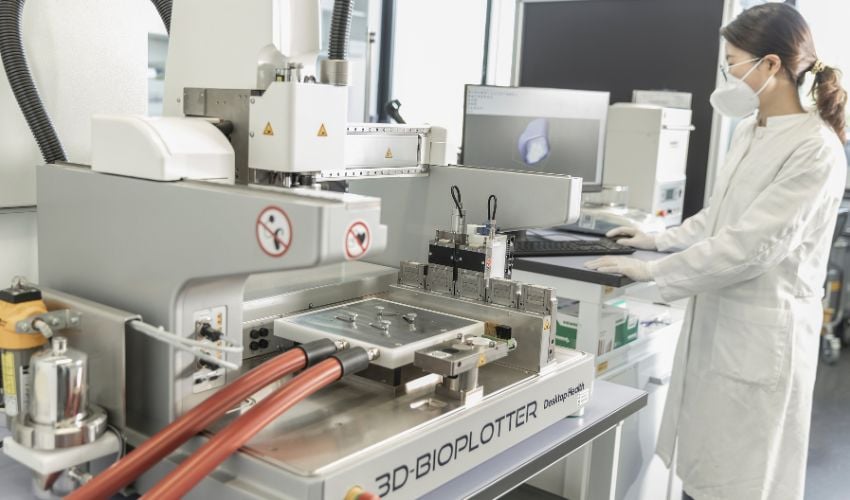Desktop Health Successfully Installs 3D Printed Custom Ear Implant

Within the realm of medical 3D printing, the possibilities opened up with technologies such as 3D bioprinting have been steadily emerging from theory into practice. Some of the most recent work being done around the world includes the ability to 3D print brain tissue as well as skin and organ tissues, opening up the potential for 3D printed transplants and cancer treatment. Elsewhere in the field, the practice of 3D printed implants and prosthetics has been instrumental in assisting patients recovering from diseases and physical accidents. Most recently, one example that combines the two practices into a functional, bioprinted implant was successfully carried out in Germany with the help of bioprinting technology from Desktop Health, the medical 3D printing division of Desktop Metal.
The feat was made possible thanks to the help of the Desktop Health 3D-Bioplotter® Manufacturing Series 3D printer. The 3D bioprinter from Desktop Health has now seen active use both in the United States and Germany. The ENT Clinic at Hannover Medical School (MHH) is the first clinic in the world that has succeeded in printing and implanting a customized drug-releasing ear implant in an adult patient.

The 3D bioprinted ear implant
MHH acquired their 3D-Bioplotter from Desktop Metal 2020 with the aim of using it to develop medical implant applications such as this one. The patient at the MHH clinic who received the ear implant had suffered from a narrowing of the ear canal that kept recurring despite repeated operations. The implant works like a stent, meaning it can prevent a passage from narrowing, while it also supplies the patient with active pharmaceutical ingredients to promote healing. “The first follow-up has already been very promising” explains Dr. Verena Scheper, whose team from the Department of Inner Ear Pharmacology at the ENT Clinic at Hannover Medical School developed the implant and printed it using the 3D printer from Desktop Health.
The ENT Clinic Director Dr. Thomas Lenarz is also positive about the result, stating, “We have thus opened the door to a new type of pioneering patient care,“. The clinic is particularly well known for having the world’s largest cochlear implant program, which was introduced to care for hearing-impaired patients. To date, over 11,000 patients have been able to receive aural assistance with a cochlear implant. The clinic is also involved in the early detection of hearing loss in childhood, the provision of hearing aids and their further development and the diagnosis and treatment of tinnitus and other types of sensorineural hearing loss. In order to provide its patients with the best possible treatment, the ENT Clinic cooperates with national acousticians, product manufacturers and researchers while also developing new medical products in-house.
3D Bioprinting with Desktop Metal
On the side of the 3D printer producer, Desktop Health and by extension, Desktop Metal, the results have been an encouraging example of 3D printing technology breaking ground into new possibilities. For the Desktop Health 3D-Bioplotter 3D printer, it is another project whose valuable data can be added to the list of projects completed by the world’s most cited and researched bioprinter in peer-reviewed scientific and medical journals.
Founder and CEO of Desktop Metal, Ric Fulop, sees the production of the ear implant as a transition into a new phase of bioprinting and explains, “The benefits of 3D bioprinting are just beginning to move into actual patients, and we celebrate this important shift in medicine that MHH and other medical innovators are driving forward. In recent months, we’ve seen the first products developed over many years on the 3D-Bioplotter moving into commercial and patient applications. We celebrate these important milestones, and what they mean for personalized patient care. […] Our entire team celebrates this important accomplishment by the Hannover Medical School ENT clinic, which has been years in the making.” For more information on their 3D printed ear implant, you can read more HERE.
What do you think of Desktop Health’s 3D printed ear implant? Let us know in a comment below or on our LinkedIn, Facebook, and Twitter pages! Don’t forget to sign up for our free weekly Newsletter here, the latest 3D printing news straight to your inbox! You can also find all our videos on our YouTube channel.
*All photo credits: Business Wire / Desktop Health






